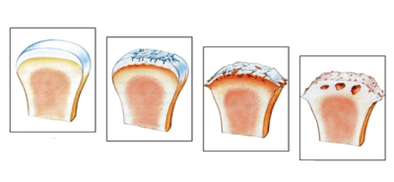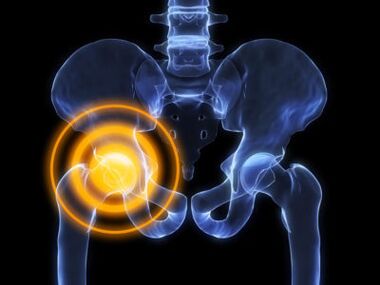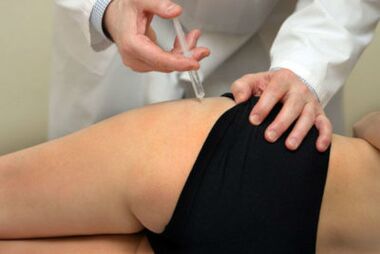Hip joint arthrosis is a complex disease with certain symptoms and complex treatment.The disease occurs in the background of metabolic disorders in the cartilaginous tissue of the joint cavity and the femur head.
Arthrosis of the hip joint or coksartrosis is more common in the elderly.It is generally accepted that inflammatory reactions play a major role in disease pathogenesis.After a large number of studies, it is evident that arthrosis occurs with atherosclerosis and disease with metabolic disorders.
The essence of the disease
Coksartrosis is a disease based on metabolic disorders with atopic and degenerative changes in the cartilage of the hip joint.
You cannot confuse arthrosis with arthritis.Unlike arthritis with arthrosis, non -burning (aseptic) inflammation occurs, which develops and develops for years.
Development pathogenesis:
- Violation of metabolic processes in cartilage.The cartilage receives nutrients using spreading.Small inflammation or edema causes a lack of trace and mineral elements.
- Against the background of the process affected by nutrients, atopic changes begin, cartilage tissue is filtered, the amount of fluid joint and condensation decreases.
- Due to the madness and destruction of the cartilage, the severe pain begins, there is a decrease in the amplitude of movement in the joints.
- The cartilage fabric is very sophisticated, a great gap is narrowing, joint dysfunction occurs.
Until the beginning of the distraction, for more than a year.The disease can only be stopped in the first stage, with the development of the third stage of osteoarthrosis, treatment aimed at reducing symptoms and claiming the patient's life, alternative to drugs - endoprosthetics.
Cause

The disease is polyethiological, there are many conditions and factors that can cause arthrosis or cause its development.If the cause of the arthrosis of the hip joint is not detected, such a disease is called idiopathic arthrosis.
The disease is not hereditary, but a genetic pathology in which cartilage displacement can cause hip joint arthrosis.
Also, the cause of coksartrosis can be such a disease:
- PERTES Syndrome - The characteristic sign of the disease is a violation of nutrient delivery to the cartilage of the joints and the femoral head.It occurs in the childhood, especially the sick boys.
- Congenital dislocation and femur subluxation.In the process of injury, inflammation and aseptic melting of cartilage and femoral heads may occur.
- Femoral head necrosis.It is caused by damage to the upper artery, which is attached to the top of the head.
- Rheumatoid and juvenile arthritis.Against the background of toxins or antibodies itself, exudative inflammation develops in the joints.
Given the fact that the disease lasts, the disease can be on one side and two.
There are many factors that contribute to the occurrence of arthrosis, they include:
- spinal disease (kyphosis, lordosis, scoliosis);
- metabolic disease of connective tissue;
- violation of blood supply to joints;
- atherosclerosis of the vessel;
- stress conditions;
- hip displacement;
- congenital deformation of the lower leg;
- infectious diseases;
- inactive lifestyle;
- alcohol intake, smoking;
- Old age.
Keep in mind that people involved in stretching are at high risk of developing arthrosis in adulthood.
Also, one of the reasons may be traumatic damage to the joint components.After tissue damage occurs, the inflammatory reaction occurs, as a result the cartilage can be replaced with a connector.
Symptom

Because the disease is slowly developing, the patient does not always pay attention to their first signs.It should be noted that with early diagnosis, the opportunity for forgiveness of the disease increases.It is very important to start treatment before, as in this way it is possible to prevent the occurrence of ankylosis and complete osteoarthrosis.
With hip joint arthrosis, symptoms can occur with different intensity depending on the load and level of the disease.
Clinical picture of osteoarthritis hip joint:
- The painful sensation that becomes severe pain in the front and side of the thigh.The patient complains that the thighs are very painful during turn or load on the joints.
- The unpleasant sensations that arise in the thighs while walking, sometimes they are combined with pain in the thighs.
- The stiffness and limitations of the mobility of the limbs in the hip joint.First, the function of leaving apart from suffering, and then everyone.
- Unpleasant noise while walking, joints can click or crisis.Continuous pathological sounds can be one sign of the disease.
- Morning stiffness, which passes within a few hours or before dinner.
Sometimes neglecting the possible consequences, people begin to take medication for symptom therapy and thus cover the development of the process of destruction in the cartilage.
Level
The clinical picture depends on the level of arthrosis of the hip joint and the reactivity of the patient's body.If symptoms occur, as a rule, changes occur in X -Rays.In medical practice, it is common to distinguish three levels of radiology, each with its own characteristics.
Arthrosis level of change in x -Rays:
Arthrosis of degree 1
It continues with minimal clinical manifestations, and therefore patients rarely seek assistance from doctors.With the early diagnosis of the disease, the patient increases the chance of complete recovery.The initial period of the disease is characterized by small pain in the pelvis and thighs, increasing pain in the background of physical work or prolonged walking.In the second place in terms of frequency of manifestation comes the symptoms of pain in the thighs.At 1 degree, the pain is exciting and rare.The amount of movement is fully preserved.In X -ray, small changes are visualized.
Degree -2
In the event of a second degree, the patient begins to interfere with the acute and frequent pain that can occur at rest.Symptoms, as a rule, are real in the evening, and morning stiffness has not passed until dinner.During prolonged transitions, symptoms of deficiencies occur, one cannot fully load the diseased joints.Discomfort occurs during flexibility or squats, the degenerative process of progress in the cartilage.Against the background of such changes, the feet can shorten, hip muscle atrophy and pelvis occur.On radiography, narrowing of the joint gap can be seen, the periostal reaction grows.A large number of osteophytes are found in the joint lumen.
The last of the last -3 arthrosis or absorb
The third stage is characterized by the incidence of lower leg motor dysfunction.The patient complains of persistent pain, which occurs for no reason.There is a shortening of limbs more than 5%, ankylosis occurs, the joints lose the ability to mobility.Radiography shows a full closure of the joint gap and a large amount of osteophytes against the background of bone deformation.The 3rd degree treatment is performed only by operation.
Method of treatment

The choice of methodology for treatment depends on the level of osteoarthritis.In the first stage, comprehensive conservative treatment is used.The hardest is the second stage, as conservative therapy is ineffective, and indications for inadequate operation.It is true -it is possible to cure arthrosis only with the development of the first stage of the disease.
After making a diagnosis of hip joint arthrosis, the doctor chose the treatment method.The most commonly used:
- Conservative treatment with medications;
- surgical treatment;
- Exercise and massage therapy.
Each treatment method has certain features, variations and goals.Conservative therapy is used for that purpose:
- The struggle against the etiological factors.For example, metabolic disorders or hormones can be corrected.
- Symptomatic treatment aims to reduce the life of the patient and relieve the symptoms of alliteration.For this purpose, non -ssteroid anti -medications are used.Often, sodium diclofenac, nimesulide, ibuprofen are used from NSAIDs.
To relieve persistent pain, NSAIDs are taken almost daily, and this can affect the patient's gastrointestinal tract and cause the development of peptic ulcer.
Surgical intervention is indicated by the third stage of arthrosis and is the only method for restoring walking function.The essence of the methodology is a complete or partial replacement of the joints along with titanium endoprostheses.
Media Physical Education is an important part of any recovery.Exercise and massage therapy is aimed at improving blood flow to the joints.Also, exercise therapy is used to reduce the risk of ankylosis.
You should be careful when doing exercises, as you can damage osteophytes together.Tactics and training should be selected by the doctor based on the characteristics of the individual and the clinical picture of the disease.



















